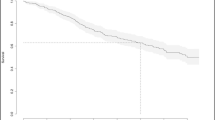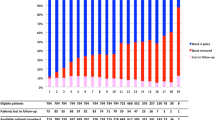Abstract
Background
This investigation assessed the long-term outcome of patients with gastric banding implanted more than 10 years ago.
Methods
A total of 73 patients undergoing laparoscopic gastric banding between 1997 and 2003 were identified. Patients who had their band removed were converted to a laparoscopic gastric bypass procedure.
Results
The mean preoperative body mass index (BMI) was 44.4 (SD 5.3). The mean follow-up was 11.6 (SD 2.1) years. The reasons for reoperation were leakage (N = 16, 21.9 %), slipping (N = 15, 20.5 %), and insufficient weight loss (N = 9, 12.3 %). The band was left in situ in 33 patients (45.2 %). The 5- and 10-year survival rates for the banding were 82.2 % (95 %CI 73.9–91.5 %) and 53.4 % (95 %CI 43.1–66.2 %). Best results were observed in male patients (10-year survival rate 76.5 %, 95 %CI 58.7–99.5 %, HR = 0.44, P = 0.043) and patients older than 50 years (10-year survival rate 63.8 %, 95 %CI 51.5–79.2 %, HR = 0.41, P = 0.006). Overall, the BMI was 31.0 (SD 6.3) at follow-up, excess weight loss was 68.1 % (SD 26.4), and the score for the Moorehead-Ardelt Questionnaire was 1.6 (SD 1.0). Similar results were obtained for patients with and without banding failure.
Conclusion
The present investigation provides evidence that gastric banding remains effective after more than 10 years in less than 50 % of initially operated patients. Older (>50 years) and male patients seemed to maintain the banding as long-time carriers with good results, and these patients subjectively profited from this method. Good results can be achieved if patients are followed thoroughly, and alternative surgical options for patients who fail may be offered with longstanding success.


Similar content being viewed by others
References
Buchwald H, Oien D. Metabolic/bariatric surgery worldwide 2011. Obes Surg. 2013;23:427–36.
Schwartz ML, Drew RL, Chazin-Caldie M. Factors determining conversion from laparoscopic to open Roux-en-Y gastric bypass. Obes Surg. 2004;14:1193–7.
Naef M, Mouton WG, Naef U, et al. Graft survival and complications after laparoscopic gastric banding for morbid obesity—lessons learned from a 12-year experience. Obes Surg. 2010;20:1206–14.
Reither EN, Hauser RM, Yang Y. Do birth cohorts matter? Age-period-cohort analyses of the obesity epidemic in the United States. Soc Sci Med. 2009;69:1439–48.
Spivak H, Favretti F. Avoiding postoperative complications with the LAP-BAND system. Am J Surg. 2002;184:31S–7.
Schmid C, Goede DL, Hauser RS, et al. Increased prevalence of high body mass index in patients presenting with pituitary tumours: severe obesity in patients with macroprolactinoma. Swiss Med Wkly. 2006;136:254–8.
Dixon JB, Dixon ME, O’Brien PE. Pre-operative predictors of weight loss at 1-year after lap-band surgery. Obes Surg. 2001;11:200–7.
Schwartz ML, Vaccarino F, Chacon M, et al. Chronic neonatal hypoxia leads to long term decreases in the volume and cell number of the rat cerebral cortex. Semin Perinatol. 2004;28:379–88.
Wittgrove AC, Clark GW, Tremblay LJ. Laparoscopic gastric bypass, roux-en-y: preliminary report of five cases. Obes Surg. 1994;4:353–7.
Ishwaran H, Kogalur UB. Consistency of random survival forests. Stat Probab Lett. 2010;80:1056–64.
Soteriades ES, Hauser R, Kawachi I, et al. Obesity and cardiovascular disease risk factors in firefighters: a prospective cohort study. Obes Res. 2005;13:1756–63.
Weber M, Muller MK, Bucher T, et al. Laparoscopic gastric bypass is superior to laparoscopic gastric banding for treatment of morbid obesity. Ann Surg. 2004;240:975–82. discussion 982–973.
Weber M, Muller MK, Michel JM, et al. Laparoscopic Roux-en-Y gastric bypass, but not rebanding, should be proposed as rescue procedure for patients with failed laparoscopic gastric banding. Ann Surg. 2003;238:827–33. discussion 833–824.
Muller MK, Attigah N, Wildi S, et al. High secondary failure rate of rebanding after failed gastric banding. Surg Endosc. 2008;22:448–53.
Angrisani L, Santonicola A, Iovino P, et al. Bariatric Surgery Worldwide 2013. Obes Surg. 2015.
Mittermair RP, Obermuller S, Perathoner A, et al. Results and complications after Swedish adjustable gastric banding-10 years experience. Obes Surg. 2009;19:1636–41.
Himpens J, Cadière G, Bazi M, et al. Long-term outcomes of laparoscopic adjustable gastric banding. Arch Surg. 2011;146:802–7.
Limitations
The study was a retrospective analysis.
Conflict of Interest
All authors declare that they have no conflict of interest.
Statement of Informed Consent
Informed consent was obtained from all individual participants included in the study.
Statement of Human and Animal Rights
All procedures performed in studies involving human participants were in accordance with the ethical standards of the institutional and/or national research committee and with the 1964 Helsinki declaration and its later amendments or comparable ethical standards.
Author information
Authors and Affiliations
Corresponding author
Additional information
Martha R. Trujillo and Dominik Muller are equally contributing authors
Rights and permissions
About this article
Cite this article
Trujillo, M.R., Muller, D., Widmer, J.D. et al. Long-Term Follow-Up of Gastric Banding 10 Years and Beyond. OBES SURG 26, 581–587 (2016). https://doi.org/10.1007/s11695-015-1800-x
Published:
Issue Date:
DOI: https://doi.org/10.1007/s11695-015-1800-x




